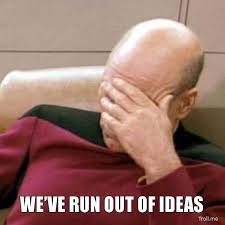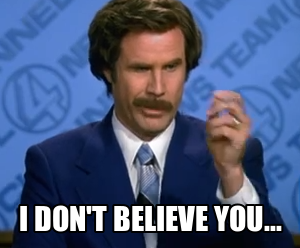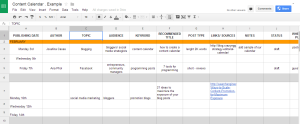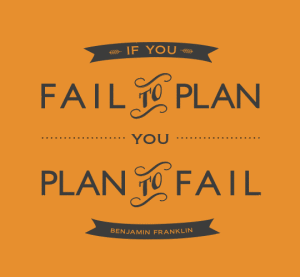
In today’s article I’m going to tell you all about how to create a content calendar, the advantages of using one and even some ideas for posts. I want you to make the most of this article so you won’t make the same mistakes I made, and if the idea appeals to you, use this resource which is essential for anyone working with content, be it a content manager, a community manager, a professional blogger or not.
A- Why is it important to create a content calendar?
I’m not going to lie: on the Internet you can find so many articles listing reasons that support the use of a calendar, its advantages, its reach, etc, which I’ll inevitably include in this point (because they are valid) but there are other reasons that I’ve observed no one reveals which I believe adjust more to the daily reality of any writer or person that administrates, creates, edits or makes a living with content, such as myself. So, in all honesty, I’ll share with you the reasons I believe to really justify the use of a calendar:
Reason #1:
It optimizes time. When you’ve failed to manage your time well and the time comes to decide what to write about, I assure you the pressure of the situation won’t help you at all to come up with ideas and basically this will happen:

Reason #2:
As a consequence of point number one, having no ideas, when the time comes to have a meeting with your boss, editor or whoever you get your pay check from, most likely something will happen which isn’t only very uncomfortable but also makes us look unprofessional if we don’t have anything clever to say: 
Reason #3:
Besides looking extremely unprofessional because you don’t have a list of good ideas for future articles, or even, for the current week, having to tell your boss you’ve fallen behind and that you probably won’t be able to deliver the article in time will result in a reaction similar to this one:

Reason #4:
As a consequence of the previous point, you’ll have to work against the clock and therefore it’s very likely you won’t create quality content, and that’s even worse, since besides disappointing your readers something like this may happen:

Reason #5:
Having to accept that for lack of organization, because you didn’t use or create a calendar, the article has to be published after the due date, for a sensitive woman such as myself, may result in ending a meeting like this:

Reason #6:
You are starting to lose authority and your boss’ trust so it’s likely he/she’ll start looking for someone else to do your job:

-
- It allows you to plan in detail coherent content that fits the commercial and communication strategy of the brand or organization.
-
- It ensures a constant flow of content in all social media channels.
-
- It optimizes the coordination with other contributors.
-
- It increases productivity
-
- It enables you to develop beforehand content that suits a calendar of key events that benefit the positioning of the product or brand.
-
- It allows you to broaden the offer of content since you can produce different formats beforehand that can’t be created spontaneously: webinars, slides, infographics, ebooks.
-
- It reinforces the engagement and your blog’s traffic: planning ahead ensures you won’t have blanks in between articles. You can feed your blog and keep your audience active.
-
- It’s the basis of the company’s social media marketing strategy.
-
- It allows you to cover all key topics for the audience and for the company or brand.
These are only some of the reasons why it’s necessary to use this resource if you really want to build a serious and productive communication channel.
B- How do I create a content calendar?
First I’d like to make it clear that there’s no ONE correct way to do this nor is there ONE template that’s better than the others. What’s important is that however you’ll design it, it needs to work for you and your team, in case you have contributors. Another important thing is: it’s likely you’ve been writing “your” or “the” blog for a while, but before moving on, if you really want this to work you need to stop right now and define basic matters that will organize your communication strategy and as a consequence the content you’ll publish. So:
1- Leave old habits behind and get prepared to start, how can I say this… over.
2- Define along with your boss or team the goals of the blog by quarter or semester, these will turn in guide article production: what do we want to achieve next semester?: brand positioning? sales? more traffic? to increase the amount of our blog’s subscribers? positioning of our site in search engines?
3- Define your audience, what do you want from them and how you’ll reach them. For those of us in charge of writing, this point is essential since it guides all of our work. Anything from the tone you’ll use to write, the language, the verb tense, the person you’ll use, the type of pictures that will appear along with the text, the type of information you can include, the color, the typography, etc, etc, etc.
4- Define the posting routine: establishing the scheme of days and schedules when you’ll publish content is paramount for the organization of individual work and the coordination with contributors, not to mention this will help you define how many columns you’ll create for your template 🙂
5-Define categories or topics your audience’s interested in: health, beauty, technology, releases, etc.
6- Define the typology of posts: lists, “how to:”, interviews, infographics, long posts, slides post, tip posts, etc.
7- Authors – contributors
8- SEO: along with the categories and the audience SEO is also important for the calendar since the selection of key words or phrases will organize it and position each article. Therefore if we want to position ourselves in a particular word this will help us. Take a look at this article where I explain how to optimize each article for SEO.
At this point more than 50% of the work for the creation of the calendar has been covered. Ok, the world won’t end anytime soon:

C- What should I include in the calendar’s template?
If you look up on the web templates for calendars you’ll see an incredible amount and variety. Surely you’ll also find most of them are too elaborate, they have hundred of columns, filters, colors… in short they are so complicated that you’d need someone to help you understand them. What’s supposed to be a solution ends up being a problem. In order to avoid frustration below I share with you a “template model” I set up for you, which happens to be very similar to the one we use at Postcron. You’ll see it’s very simple but super effective, that’s how we like it: quick, simple, practical, just straightforward. A tool that really saves time.
Before showing you the model I’d like to recommend the following item list with basic points that organize a calendar. Anyway, I remind you there’s nothing that no matter what has to be included in a template. It must work for you so you can exercise your “free will”.

- Publishing date
- Title / Suggested titles
- Author
- Keywords (important for SEO)
- Audience
- Status: draft, scheduled, published
- Type of post (How to, Interviews, 7 tips for…, Successful cases, etc)
- Links: those which serve as an inspiration for the post, research, other articles, infographics.
- Notes: ideas, anything that’s extra.
- Where it’ll be published: guest blog, news page, social networks.
- Metrics – Goals
And here’s our model! You can check it out on line, from this link :
D- What calendar should I use?
As I said before, there’s a huge offer of tools, templates, plugins and so forth in order to create calendars online. None is good or bad, it mostly depends on the volume and complexity of your work. It won’t be the same for an individual writer and an online magazine that has a whole publishing department to coordinate. In my opinion Google Calendar and Google Drive’s templates suffice in either case. It’s free, collaborative, you customize it and it’s synchronized with the rest of the elements in Google’s package, among other benefits. However, I share with you other options so you can compare them:
E- Are you running out of ideas for posts?
In order to draw the article to a close I’ll review with you some ideas that can serve as an ace up your sleeve in case creativity decides to take leave:
Interviews, surveys, rankings, lists, reviews, tip posts, “how to” posts, manuals, e-books, etc. You can also turn posts with loads of information into infographics, update old ones, make videos to explain a new tool’s “step by step”, invite other bloggers, and if you need more ideas you can use this post we explain how to use it.
Final words
I hope you find my prior experience useful and that you are encouraged to create your own content calendar. Remember a calendar’s purpose is to get you organized, not stuck. It should fit the general marketing strategy of the company and be dynamic, it should be reviewed and optimized periodically (monthly) in order to achieve the goals set, either related to traffic or impact of social media channels, just to give you an example of basic matters to be analyzed.
You can use this template to start planning now and remember to assess at least every 30 days the results of each post (views and amount of shares, likes, etc.) to determine which are the topics and types of posts that have the greater amount of visits, shares or conversions, depending on your goals.
The content calendar is closely related to and it is itself the basis of a social media marketing strategy, therefore, it is key to measure the results of each channel (Facebook, Twitter, Google+ and LinkedIn); so it will make your job easier, we include these in the template.
Do you have any doubts? I’m looking forward to your comments!

